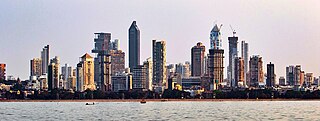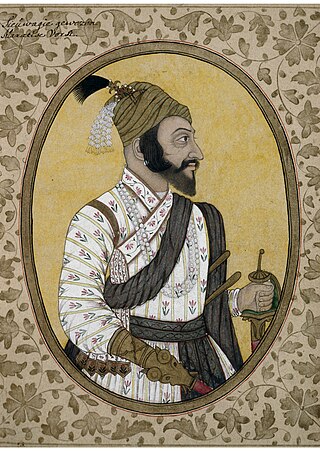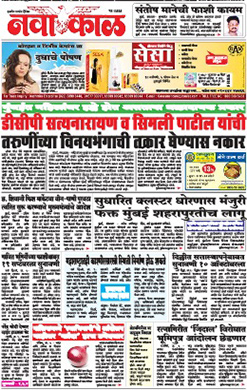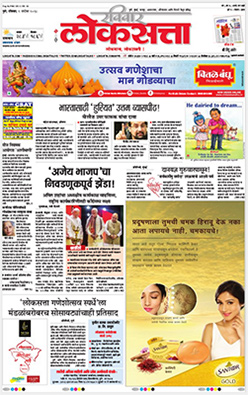
Mumbai is the capital city of the Indian state of Maharashtra. Mumbai is the financial capital and the most populous city of India with an estimated population of 12.5 million (1.25 crore). Mumbai is the centre of the Mumbai Metropolitan Region, the sixth-most populous metropolitan area in the world with a population of over 23 million. Mumbai lies on the Konkan coast on the west coast of India and has a deep natural harbour. In 2008, Mumbai was named an alpha world city. Mumbai has the highest number of billionaires out of any city in Asia.

Marathi is an Indo-Aryan language predominantly spoken by Marathi people in the Indian state of Maharashtra and is also spoken in other states like in Goa, Karnataka, Tamil Nadu, Andhara Pradesh, Telangana, Gujarat, Madhya Pradesh, Chhattisgarh, and the territory of Daman and Diu. It is the official language of Maharashtra, and an additional official language in the state of Goa, where it is used for replies, when requests are received in Marathi. It is also commonly spoken in the Damaon territory, but with no official status. It is one of the 22 scheduled languages of India, with 83 million speakers as of 2011. Marathi ranks 13th in the list of languages with most native speakers in the world. Marathi has the third largest number of native speakers in India, after Hindi and Bengali. The language has some of the oldest literature of all modern Indian languages. The major dialects of Marathi are Standard Marathi and the Varhadi Marathi.

Maharashtra is a state in the western peninsular region of India occupying a substantial portion of the Deccan Plateau. It is bordered by the Arabian Sea to the west, the Indian states of Karnataka and Goa to the south, Telangana to the southeast and Chhattisgarh to the east, Gujarat and Madhya Pradesh to the north, and the Indian union territory of Dadra and Nagar Haveli and Daman and Diu to the northwest. Maharashtra is the second-most populous state in India.

Vinayak Narahari Bhave, also known as Vinoba Bhave, was an Indian advocate of nonviolence and human rights. Often called Acharya, he is best known for the Bhoodan Movement. He is considered as National Teacher of India and the spiritual successor of Mahatma Gandhi. He was an eminent philosopher. He translated the Bhagavad Gita into the Marathi language by him with the title Geetai.

Shivaji I was an Indian ruler and a member of the Bhonsle dynasty. Shivaji carved out his own independent kingdom from the Sultanate of Bijapur that formed the genesis of the Maratha Confederacy. In 1674, he was formally crowned the Chhatrapati of his realm at Raigad Fort.

Bajirao I was the 7th and greatest Peshwa of the Maratha Confederacy. He, after Chhatrapati Shivaji, is considered to be the most charismatic and dynamic leader in Maratha history. He was just twenty years old and already had a reputation for rapid decisions and a passion for military adventure.

Languages spoken in the Republic of India belong to several language families, the major ones being the Indo-Aryan languages spoken by 78.05% of Indians and the Dravidian languages spoken by 19.64% of Indians; both families together are sometimes known as Indic languages. Languages spoken by the remaining 2.31% of the population belong to the Austroasiatic, Sino–Tibetan, Tai–Kadai, and a few other minor language families and isolates. According to the People's Linguistic Survey of India, India has the second highest number of languages (780), after Papua New Guinea (840). Ethnologue lists a lower number of 456.

Jyotirao Govindrao Phule, also known as Jyotiba Phule, was an Indian social activist, businessman, anti-caste social reformer and writer from Maharashtra. His work extended to many fields, including eradication of untouchability and the caste system and for his efforts in educating women and oppressed caste people. He and his wife, Savitribai Phule, were pioneers of women's education in India. Phule started his first school for girls in 1848 in Pune at Tatyasaheb Bhide's residence or Bhidewada. He, along with his followers, formed the Satyashodhak Samaj to attain equal rights for people from lower castes. People from all religions and castes could become a part of this association which worked for the upliftment of the oppressed classes. Phule is regarded as an important figure in the social reform movement in Maharashtra. The honorific Mahātmā, was first applied to him in 1888 at a special program honoring him in Mumbai.

Bhil or Bheel refer to various indigenous groups inhabiting western India, including parts of Rajasthan and Madhya Pradesh and are also found in distant places such as Bengal and Tripura. They speak various languages of Indo-Aryan origin, owing to language shift, collectively referred to as the Bhil languages. Bhils are divided into a number of endogamous territorial divisions, which in turn have a number of clans and lineages.

Navakal is a Marathi daily newspaper. It is based in Mumbai, the capital of the Indian state of Maharashtra. Its owner editor is Nilkanth Khadilkar. Robin Jeffery has called Khadilkar one of the most remarkable and self-reliant owners of small newspapers. In the context of pre-independence Mumbai, it has been described as a Congress paper, contemporarily it has been considered to be aligned with the Shiv Sena. In 1999 Nava Kaal had a circulation share of 8% and a readership share of 27% for all of Maharashtra, in the 1950s Nava Kaal's circulation under Nilkanth Khadilkar's father had fallen to 800 and the paper was nearly closed.

Mastani was the daughter of Chhatrasal and Ruhani Bai Begum. She was the second wife of the Maratha Peshwa Baji Rao I. Her relationship within the Maratha Brahmin family has been subject of both admiration and controversy and well adapted in Indian novels and cinema.

Gita Mehta was an Indian-American writer and documentary filmmaker. As a journalist and documentary filmmaker she frequently covered war and conflict including covering the Bangladesh liberation war of 1971. As an author she published five books which were translated into 21 languages. Her works described aspects of life in India and were intended to interpret the country for a largely western audience.

The Marathi people or Marathis are an Indo-Aryan ethnolinguistic group who are native to Maharashtra in western India. They natively speak Marathi, an Indo-Aryan language. Maharashtra was formed as a Marathi-speaking state of India on 1 May 1960, as part of a nationwide linguistic reorganisation of the Indian states. The term "Maratha" is generally used by historians to refer to all Marathi-speaking peoples, irrespective of their caste; However, it may refer to a Maharashtrian caste known as the Maratha which also includes farmer sub castes like the Kunbis.
Rajmatoshree Shrimant Soyarabai Saheb Bhosale(Mohite) died 1681) was second wife of Shivaji Maharaj, the founder of Maratha empire in western India. She was mother of Shivaji Maharaj's second son, Rajaram. She was the younger sister of Maratha army chief Hambirrao Mohite.
Ranjit Ramchandra Desai was an Indian Marathi-language writer from Maharashtra, India. He is best known for his historical novels Swami and Shriman Yogi. He was awarded the Sahitya Akademi Award in 1964 and the Padma Shri in 1973.
Maha Bhakta vijaya is a Marathi text by Mahipati around 1762 that extols the deeds of the saint-poets of the Varkari sect of Hinduism. It has been translated into various languages in India and is widely read. It forms an important part of the prayer for devotees of Vithoba at Pandharpur. An English translation was published under the provisions of the will of Justin E. Abbott in 1933.

Loksatta (Lōksattā) is a Marathi daily newspaper in Maharashtra, India. It is published by The Indian Express Group and was launched on 14 January 1948. Loksatta is published in Mumbai, Pune, Nagpur, Thane, Palghar, Ahmednagar, Amravati, Aurangabad and Nashik.
Hindusthan Samachar is the first multilingual news agency in India, subscribed by more than 200 newspapers and almost all the news channels including Doordarshan (DD).

Maharashtra is a state in the western region of India. It is India's second-most populous state and third-largest state by area. The region that comprises the state has a long history dating back to approximately 1300–700 BCE, although the present-day state was not established until 1960 CE.

Suniti Ashok Deshpande, was an Indian educator, writer, translator and interpreter, best known for her work on spreading the Russian language and culture in India.
















